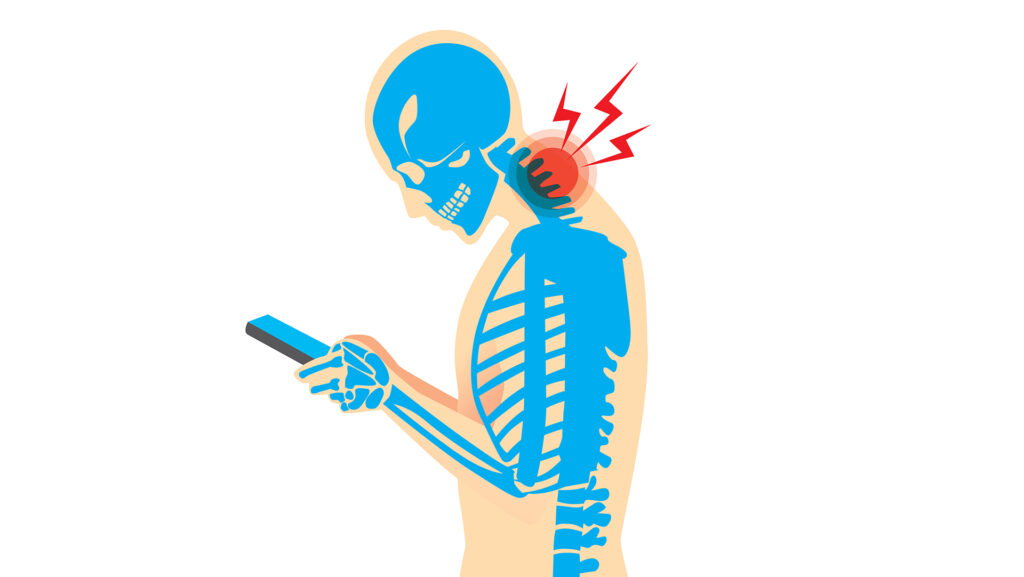
Ever catch yourself hunched over your phone for hours? Neck aching? Shoulders sore? Welcome to the club where the price of staying connected is paid with poor posture and persistent pain.
This modern phenomenon has a name: Text Neck.
While it might sound like a meme worthy condition, it’s a very real and growing problem. As our screen time goes up, so does the toll it takes on our neck, shoulders, and spine. And the worst part? Most people don’t even realise it’s happening until the discomfort becomes a daily thing.
Let’s break it down and talk about what text neck is, how it affects your body, and most importantly what you can do to fix it.
What is Text Neck?
Text neck is a term used to describe the repetitive strain and pain in the neck and upper back resulting from looking down at phones, tablets, or laptops for long periods.
When your head is upright and aligned with your spine, it weighs about 10-12 pounds. But for every inch your head tilts forward, the pressure on your neck muscles increases significantly. At a 45-degree angle (a common angle when texting), your neck can feel like it’s supporting up to 49 pounds!
That’s like carrying a small child on your neck for hours.
Signs and Symptoms of Text Neck
Not sure if you’ve got it? Here are some common signs:
- Dull, aching pain in the neck or upper back
- Stiffness in the neck or shoulders
- Frequent headaches, especially at the base of the skull
- Sharp pain when turning the head
- Tingling or numbness in the arms (in severe cases)
- A forward head posture or rounded shoulders
If you’re experiencing any of these on a regular basis and spend a lot of time on your devices, text neck could be the culprit.
Who is at Risk?
The short answer? Almost everyone.
From teenagers glued to their phones, to office workers crouched over laptops, and even parents scrolling through news or emails text neck doesn’t discriminate.
It’s especially common among:
- Students and young adults
- People who work in tech or desk-based jobs
- Gamers
- Remote workers
- Social media scrollers (yes, we see you!)
The Long-Term Impact
Ignoring text neck can lead to more than just temporary discomfort. Over time, poor posture and chronic strain can lead to:
- Early wear and tear on the spine
- Herniated discs
- Muscle imbalances
- Shoulder impingement
- Reduced lung capacity due to poor chest expansion
Plus, research suggests that poor posture can even affect your mood, confidence, and energy levels. So this isn’t just a physical issue it impacts your overall well-being.
How Can Physiotherapy Help?
The good news? You don’t have to live with text neck. A physiotherapist can help you undo the damage and prevent it from coming back.
Here’s how:
1. Postural Assessment and Correction
Your physio will start by assessing your posture and how you move. They’ll help you identify any muscle imbalances or joint restrictions contributing to your discomfort.
You’ll learn:
- How to properly align your head, shoulders, and spine
- The best ergonomic setup for your phone, desk, or laptop
- What habits to break (and new ones to build!)
2. Hands-On Therapy
Many people benefit from manual therapy techniques such as:
- Soft tissue release to ease muscle tension
- Joint mobilisation to improve spinal movement
- Trigger point therapy to reduce referred pain (especially with headaches)
These techniques help reduce pain and restore mobility quickly.
3. Targeted Exercises
Physiotherapists will give you simple but effective exercises to strengthen your neck, shoulders, and upper back. These might include:
- Chin tucks
- Scapular retractions
- Thoracic extension exercises
- Deep neck flexor strengthening
The goal is to build a stronger support system for your neck and improve your posture long-term.
4. Education & Lifestyle Advice
You’ll also get personalised advice on managing screen time, setting reminders to move, and practical tips to stay pain-free.
It’s all about building habits that fit into your lifestyle without completely unplugging from the digital world.
What You Can Start Doing Today
If you think you’ve got text neck, don’t wait. Here are a few quick tips you can start using right away:
- Lift your phone to eye level instead of bending your neck down
- Take regular breaks– every 20-30 minutes, stretch and move
- Strengthen your postural muscles with simple daily exercises
- Adjust your workstation: screen at eye level, chair with back support
- Use voice to text or hands-free options when possible
These small changes can make a huge difference.
Final Thoughts
We live in a digital age it’s not realistic to abandon our devices. But that doesn’t mean we have to sacrifice our necks for connectivity.
Text neck may be common, but it’s not something you have to live with. With a little awareness, some smart adjustments, and the help of a physiotherapist, you can stay connected and pain-free.
At Red Physiotherapy in Northampton, we specialise in treating posture related conditions like text neck. Whether you’re dealing with ongoing pain or just want to improve your habits before it gets worse, we’re here to help.
Let’s straighten things out one spine at a time.
Struggling with neck or shoulder pain? Book an assessment with us at Red Physiotherapy and take the first step towards better posture and less pain.
To book your appointment, call on the number below-
📞 Call 01604 385343 (Northampton) or 01908 713973 (Milton Keynes) or Book Online today!

